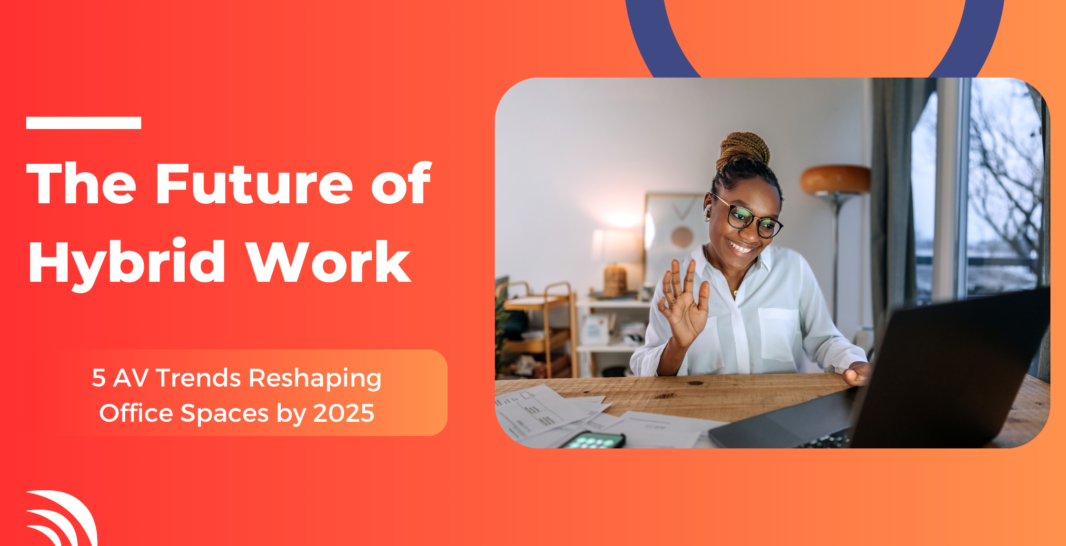As businesses continue navigating the evolving landscape of work, one thing has become clear: hybrid work is here to stay. Initiated as an urgent response to the COVID-19 pandemic, the hybrid work model has grown into a long-term solution for countless organizations looking to offer flexibility without compromising productivity. The workplace of the future will no longer hinge purely on physical infrastructure but on a sophisticated interplay of virtual and in-office experiences.
A pivotal player in creating this future? Audiovisual (AV) technology. By 2025, AV innovations won’t just be enhancing meeting rooms—they’ll be foundational in how organizations communicate, collaborate, and create. Let’s explore the top five AV trends revolutionizing the future of hybrid work and reshaping office spaces as we know them.
1. AI-Powered Meeting Room Analytics
What It Is:
AI-powered analytics are transforming meeting rooms into dynamic, responsive environments. These systems can detect room occupancy, monitor user behavior, and even track equipment usage. By collecting and analyzing real-time data, AI systems offer insights on employee patterns, predict room scheduling needs, and optimize a space’s usability and climate.
Impact on Hybrid Work:
For hybrid workplaces, managing resources efficiently is paramount. AI-driven tools can analyze how often specific meeting rooms or workspaces are utilized, ensuring that office layouts can be adjusted to maximize productivity. AI can also predict resource usage, automating responsibilities like adjusting lighting, HVAC, or AV equipment. The result? These smart meeting rooms provide both in-office and remote users with a seamless, optimized experience.
Additionally, AI lets office managers evaluate user behavior, such as which collaborative tools are most popular or how often specific technologies are used during meetings. With the collective data, companies can tailor their hybrid spaces for both efficiency and employee satisfaction while managing their resources more effectively.
Preparation Tips for Businesses:
- Embed AI-enabled AV platforms that integrate well with your existing tech stack—whether it’s Microsoft Teams, Zoom, or other hybrid-friendly applications.
- Prioritize data privacy. As AI tracks room occupancy and behavior, it’s essential to ensure strict adherence to compliance and privacy regulations to build employee trust.
2. Seamless Integration of Remote and In-Office Collaboration Tools
What It Is:
The future of collaboration lies in unified communication platforms that connect on-site workers with their remote peers through a seamless, real-time experience. Technologies like 4K video conferencing systems, interactive whiteboards, and cloud-based collaboration platforms are bridging the gap between physical and virtual spaces.
Impact on Hybrid Work:
The challenge many hybrid workplaces face is ensuring that remote employees feel as engaged and connected as those physically in the office. In 2025, expect to see more inclusive communication tools ensuring that anyone—whether remote or on-site—can participate equally. Virtual meetings will no longer feel like an afterthought for remote attendees, thanks to next-generation video conferencing technologies and advanced collaborative tools like smart whiteboards that sync in real-time across continents.
Additionally, these tools aim to eliminate any risk of delays or technical glitches, ensuring both remote and in-office workers can collaborate as if they were in the same room. Improved audio quality, clearer visuals, and integrated workspace platforms will make it easier for dispersed teams to create a connected, high-performing workforce.
Preparation Tips for Businesses:
- Invest in hybrid-friendly, collaborative tools like Miro, Slack, and virtual whiteboards—then train employees to use them efficiently.
- Revamp your tech support for remote employees by supplying them with high-quality AV equipment that reduces the likelihood of connection issues or compatibility problems with office-based systems.
3. Advanced Noise Cancellation and Acoustic Solutions
What It Is:
Distraction is the enemy of productivity. Advanced noise cancellation technologies and sound-dampening acoustic treatments are fast becoming integral to hybrid work environments. Whether employees are working from home or from the office, these technologies are designed to block out disruptive ambient noises for clearer, more focused interactions.
Impact on Hybrid Work:
Noise pollution is a common deterrent in open-plan offices and home workspaces. With employees collaborating from various locations, both in physical offices and home environments, maintaining focus is a challenge. Enter advanced noise-canceling technologies. High-performance noise-canceling headsets, floor-to-ceiling acoustic treatments for meeting rooms, and even acoustic AI can sort and filter human speech from environmental sounds, offering uninterrupted, professional interactions during meetings.
For hybrid meetings, this means a more polished and professional presentation each time, helping remote collaborators hear and understand with minimal distractions.
Preparation Tips for Businesses:
- Equip meeting rooms and workspaces with advanced acoustic treatments and high-quality noise-canceling microphones.
- Provide remote employees with top-tier noise-canceling headsets to ensure clear communication and minimized distraction in home environments.
4. Touchless AV Control Systems
What It Is:
Touchless AV control systems allow users to manage AV equipment without physically interacting with shared devices. Controlled by mobile apps, voice commands, or gesture-based inputs, these solutions limit surface contact and enhance user convenience.
Impact on Hybrid Work:
Post-pandemic, businesses have become more health-conscious, and employees expect higher standards of hygiene in the office. Touchless technology plays into that expectation by reducing the need to physically touch shared AV equipment like remotes, touchscreens, or control panels. This ensures a more hygienic environment while fostering effortless operation of AV systems, whether it’s initiating video calls, adjusting lighting, or even controlling digital displays during presentations.
Beyond health considerations, these systems deliver an intuitive, streamlined user experience. By enabling quick and easy voice commands or app-based control, they make AV setups simpler, helping employees focus more on tasks and less on technology.
Preparation Tips for Businesses:
- Install touchless AV systems that can integrate or overlay onto your current infrastructure to avoid excessive additional spending.
- Educate employees on touch-free technologies like voice-controlled meeting systems powered by familiar platforms like Amazon Alexa or Google Assistant.
5. Immersive and Interactive AV Experiences for Training and Collaboration
What It Is:
Potentially the most exciting trend shaping hybrid workspaces, immersive AV experiences leverage augmented and virtual reality (AR/VR) for more dynamic and engaging employee interactions. Virtual training sessions, immersive onboarding, and even mixed-reality collaborative meetings are becoming viable additions to the hybrid work environment.
Impact on Hybrid Work:
Employee engagement can be hard to maintain in traditional meetings or training sessions, especially when some participants are in-person, and others are remote. Enter AR and VR, which can create immersive, interactive experiences for employees—whether they’re being onboarded, trained, or collaborating on complex projects. These technologies allow employees to interact with digital environments or simulations in ways that were previously unimaginable, making learning and collaboration more engaging and effective.
Preparation Tips for Businesses:
- Experiment with AR/VR technologies in your training programs and collaborative efforts to find out their potential for your business needs.
- Consider investing early in mixed-reality systems for a competitive edge in engaging remote and in-office employees alike.
As hybrid work continues to evolve, it’s clear that AV technologies will play a vital role in designing and enhancing office environments. From AI-powered meeting rooms to immersive training experiences, these AV trends will ensure that companies embracing hybrid work in 2025 are equipped with the tools needed to create more productive, engaging, and efficient workplaces for all.
VIcom would love to sit down and discuss the technology plans for your organization in 2025. If you’re ready to start planning – simply fill out the form below and we’ll be in contact!

